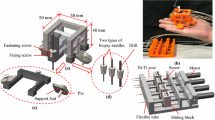Abstract
Purpose
Design a compact, ergonomic, and safe endoscope positioner dedicated to the sino-nasal tract, and the anterior and middle-stage skull base.
Methods
A motion and force analysis of the surgeon’s movement was performed on cadaver heads to gather objective data for specification purposes. An experimental comparative study was then performed with three different kinematics, again on cadaver heads, in order to define the best architecture satisfying the motion and force requirements.
Results
We quantified the maximal forces applied on the endoscope when traversing the sino-nasal tract in order to evaluate the forces that the robot should be able to overcome. We also quantified the minimal forces that should not be exceeded in order to avoid damaging vital structures. We showed that the entrance point of the endoscope into the nostril could not be considered, as in laparoscopic surgery, as a fixed point but rather as a fixed region whose location and dimensions depend on the targeted sinus.
Conclusion
From the safety and ergonomic points of view, the best solution would be a co-manipulated standard 6-degree of freedom robot to which is attached a gimbal-like passive remote manipulator holding the endoscope.









Similar content being viewed by others
Notes
References
Wigand ME (1981) Transnasal ethmoidectomy under endoscopical control. Rhinology 19(1):7–15
Stammberger H (1985) Personal endoscopic operative technic for the lateral nasal wall-an endoscopic surgery concept in the treatment of inflammatory diseases of the paranasal sinuses. Laryngol Rhinol Otol (Stuttg) 64(11):559–566
Klimek L, Mösges R (1998) Computer-assisted surgery in the ENT specialty. Developments and experiences from the first decade. Laryngorhinootologie 77(5):275–282
Justice JM, Orlandi RR (2012) An update on attitudes and use of image-guided surgery. Int Forum Allergy Rhinol 2(2):155–159
O’Malley BW, Weinstein GS (2007) Robotic anterior and midline skull base surgery: preclinical investigations. Int J Radiat Oncol Biol Phys 69(2 Suppl):S125–S128
Arora A, Cunningham A, Chawdhary G, Vicini C, Weinstein GS, Darzi A et al (2011) Clinical applications of Telerobotic ENT-Head and Neck surgery. Int J Surg 9(4):277–284
Lee JYK, O’Malley BW, Newman JG, Weinstein GS, Lega B, Diaz J et al (2010) Transoral robotic surgery of the skull base: a cadaver and feasibility study. ORL J Otorhinolaryngol Relat Spec 72(4):181–187
McCool RR, Warren FM, Wiggins RH, Hunt JP (2010) Robotic surgery of the infratemporal fossa utilizing novel suprahyoid port. Laryngoscope 120(9):1738–1743
Hanna EY, Holsinger C, DeMonte F, Kupferman M (2007) Robotic endoscopic surgery of the skull base: a novel surgical approach. Arch Otolaryngol Head Neck Surg 133(12):1209–1214
Strauss G, Hofer M, Kehrt S, Grunert R, Korb W, Trantakis C et al (2007) Manipulator assisted endoscope guidance in functional endoscopic sinus surgery: proof of concept. HNO 55(3):177–184
Wurm J, Dannenmann T, Bohr C, Iro H, Bumm K (2005) Increased safety in robotic paranasal sinus and skull base surgery with redundant navigation and automated registration. Int J Med Robot 1(3):42–48
Eichhorn KWG, Bootz F (2011) Clinical requirements and possible applications of robot assisted endoscopy in skull base and sinus surgery. Acta Neurochir Suppl 109:237–240
Nimsky C, Rachinger J, Iro H, Fahlbusch R (2004) Adaptation of a hexapod-based robotic system for extended endoscope-assisted transsphenoidal skull base surgery. Minim Invasive Neurosurg 47(1):41–46
Xia T, Baird C, Jallo G, Hayes K, Nakajima N, Hata N et al (2008) An integrated system for planning, navigation and robotic assistance for skull base surgery. Int J Med Robot 4(4):321–330
Arun KS, Huang TS, Blostein SD (1987) Least-squares fitting of two 3-D point sets. IEEE Trans Pattern Anal Mach Intell 9(5):698–700
Besl PJ, McKay ND (1992) A method for registration of 3-D shapes. IEEE Trans Pattern Anal Mach Intell 14(2):239–256
Samin JC, Fisette P (2004) Symbolic modeling of multibody systems. Springer, ISBN 978-9-04816-425-7
Dombre E, Poignet P, Pierrot F (2012) Design of medical robots. In: Troccaz J (ed) Medical robotics, ISTE Ltd. Wiley, London, p. 141–176, ISBN 978-1-84821-334-0
Herman B, Dehez B, Tran Duy K, Raucent B, Dombre E, Krut S (2009) Design and preliminary in vivo validation of a robotic laparoscope holder for minimally invasive surgery. Int J Med Robot Comput Assist Surg 5(3):319–326
Voros S, Orvain E, Long JA, Cinquin P (2007) Automatic detection of instruments in laparoscopic images: a first step towards high level command of robotized endoscopic holders. The Int J Robotics Res 26(11–12):1173–2119
Jarrassé N, Tagliabue M, Robertson J, Maiza A, Crocher V, Roby-Brami A, Morel G (2010) A methodology to quantify alterations in human upper limb movement during co-manipulation with an exoskeleton. IEEE Trans Neural Syst Rehabil Eng 18(4):389–397
Acknowledgments
Conflict of Interest
The authors declare that they have no conflict of interest.
Author information
Authors and Affiliations
Corresponding author
Rights and permissions
About this article
Cite this article
Trévillot, V., Sobral, R., Dombre, E. et al. Innovative endoscopic sino-nasal and anterior skull base robotics. Int J CARS 8, 977–987 (2013). https://doi.org/10.1007/s11548-013-0839-1
Received:
Accepted:
Published:
Issue Date:
DOI: https://doi.org/10.1007/s11548-013-0839-1




